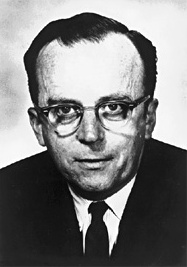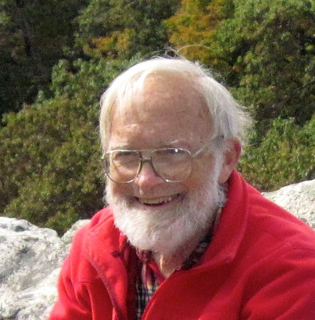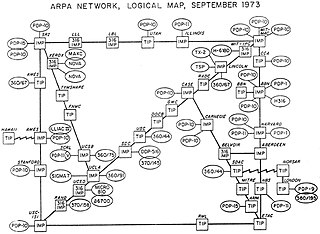Related Research Articles
The end-to-end principle is a design framework in computer networking. In networks designed according to this principle, guaranteeing certain application-specific features, such as reliability and security, requires that they reside in the communicating end nodes of the network. Intermediary nodes, such as gateways and routers, that exist to establish the network, may implement these to improve efficiency but cannot guarantee end-to-end correctness.

Raytheon BBN is an American research and development company based in Cambridge, Massachusetts, United States.

The Advanced Research Projects Agency Network (ARPANET) was the first wide-area packet-switched network with distributed control and one of the first computer networks to implement the TCP/IP protocol suite. Both technologies became the technical foundation of the Internet. The ARPANET was established by the Advanced Research Projects Agency (ARPA) of the United States Department of Defense.

Joseph Carl Robnett Licklider, known simply as J. C. R. or "Lick", was an American psychologist and computer scientist who is considered to be among the most prominent figures in computer science development and general computing history.

William Crowther is an American computer programmer, caver, and rock climber. He is the co-creator of Colossal Cave Adventure from 1975 onward, a seminal computer game that influenced the first decade of video game design and inspired the text adventure game genre.
The Network Control Protocol (NCP) was a communication protocol for a computer network in the 1970s and early 1980s. It provided the transport layer of the protocol stack running on host computers of the ARPANET, the predecessor to the modern Internet.

Robert Elliot Kahn is an American electrical engineer who, along with Vint Cerf, first proposed the Transmission Control Protocol (TCP) and the Internet Protocol (IP), the fundamental communication protocols at the heart of the Internet.
Richard Henry Bolt was an American physics professor at MIT with an interest in acoustics. He was one of the founders of the company Bolt, Beranek and Newman, which built the ARPANET, a forerunner of the Internet.

Wesley Allison Clark was an American physicist who is credited for designing the first modern personal computer. He was also a computer designer and the main participant, along with Charles Molnar, in the creation of the LINC computer, which was the first minicomputer and shares with a number of other computers the claim to be the inspiration for the personal computer.
The BBN Butterfly was a massively parallel computer built by Bolt, Beranek and Newman in the 1980s. It was named for the "butterfly" multi-stage switching network around which it was built. Each machine had up to 512 CPUs, each with local memory, which could be connected to allow every CPU access to every other CPU's memory, although with a substantially greater latency than for its own. The CPUs were commodity microprocessors. The memory address space was shared.

The Pluribus multiprocessor was an early multi-processor computer designed by BBN for use as a packet switch in the ARPANET. Its design later influenced the BBN Butterfly computer.

The Interface Message Processor (IMP) was the packet switching node used to interconnect participant networks to the ARPANET from the late 1960s to 1989. It was the first generation of gateways, which are known today as routers. An IMP was a ruggedized Honeywell DDP-516 minicomputer with special-purpose interfaces and software. In later years the IMPs were made from the non-ruggedized Honeywell 316 which could handle two-thirds of the communication traffic at approximately one-half the cost. An IMP requires the connection to a host computer via a special bit-serial interface, defined in BBN Report 1822. The IMP software and the ARPA network communications protocol running on the IMPs was discussed in RFC 1, the first of a series of standardization documents published by what later became the Internet Engineering Task Force (IETF).

Lawrence Gilman Roberts was an American engineer who received the Draper Prize in 2001 "for the development of the Internet", and the Principe de Asturias Award in 2002.
The Voice Funnel was an experimental high-speed interface between digitized speech streams and a packet switching communications network, in particular the ARPANET. It was built in the time frame from 1979 to 1981. It may be viewed as an early Voice over IP voice and video telephone.
Daniel L. Murphy is an American computer scientist notable for his involvement in the development of TECO, the operating systems TENEX and TOPS-20, and email.

Frank Evans Heart was an American computer engineer influential in computer networking. After nearly 15 years working for MIT Lincoln Laboratory, Heart worked for Bolt, Beranek and Newman from 1966 to 1994, during which he led a team that designed the first routing computer for the ARPANET, the predecessor to the Internet.

The BBN Time-Sharing System was an early time-sharing system created at Bolt, Beranek and Newman (BBN) for the PDP-1 computer. It began operation in September 1962.

SATNET, also known as the Atlantic Packet Satellite Network, was an early satellite network that formed an initial segment of the Internet. It was implemented by BBN Technologies under the direction of the Advanced Research Projects Agency.
David Corydon Walden was an American computer scientist who contributed to the engineering development of the ARPANET, a precursor of the modern internet. He specifically contributed to the Interface Message Processor, which was the packet switching node for the ARPANET. Walden was a contributor to IEEE Computer Society's Annals of the History of Computing and was a member of the TeX Users Group.
References
- ↑ Ornstein, S.M.; Stucki, M.J.; Clark, W.A. (1967), "A functional description of macromodules", Proceedings of the April 18-20, 1967, spring joint computer conference on - AFIPS '67 (Spring), pp. 337–355, doi:10.1145/1465482.1465537, ISBN 9781450378956, S2CID 17430862 , retrieved 2010-08-26
{{citation}}: CS1 maint: date and year (link) - ↑ "Chinese computer progress surprises Harvard expert". Christian Science Monitor . 1972-08-29. p. 10.
- ↑ Ken A Pier (1983), "A retrospective on the Dorado, a high-performance personal computer" (PDF), Proceedings of the 10th Annual International Symposium on Computer Architecture: 269, archived from the original (PDF) on 2011-02-18, retrieved 2010-08-26
- ↑ Roads, C. (Autumn 1981). "A Note on Music Printing by Computer". Computer Music Journal. The MIT Press. 5 (3): 57–59. doi:10.2307/3679986. JSTOR 3679986.
- ↑ Severo Ornstein (2002). Computing in the Middle Ages: A View from the Trenches 1955-1983. Lexington, KY: 1st Books. ISBN 978-1-4033-1517-5.
- Oral history interview with Severo Ornstein, Charles Babbage Institute, University of Minnesota. Ornstein describes his experience at Lincoln Laboratory which included work on the SAGE, TX-2 and LINC computers. He discusses his move to Washington University, and the later work there on DARPA/IPTO sponsored macromodule project. As the principal hardware designer of the Interface Message Processor (IMP) for the ARPANET, Ornstein describes the IMP design work at Bolt Beranek and Newman (BBN), the working environment of the group at BBN, his relationship with Lawrence Roberts, his interactions with Honeywell, and his work on the Pluribus multi-processor IMP. Ornstein also discusses the contributions of Wesley Clark and Norman Abramson, his involvement with the Computer Professionals for Social Responsibility, and his views on artificial intelligence and time-sharing.
- Oral history interview with Severo Ornstein and Laura Gould, Charles Babbage Institute, University of Minnesota. Oral history interview by Bruce Bruemmer, 17 November 1994, Woodside, California, discussing the formation and activities of Computer Professionals for Social Responsibility.
- A Brief History of ARPANET, mentioning Ornstein
- Severo's website on the composer Leo Ornstein, his father